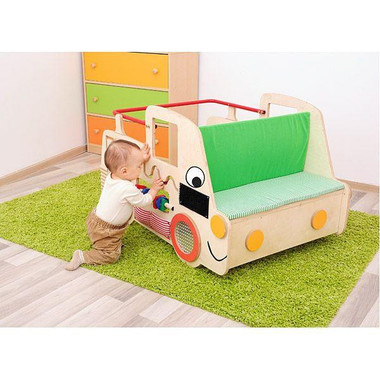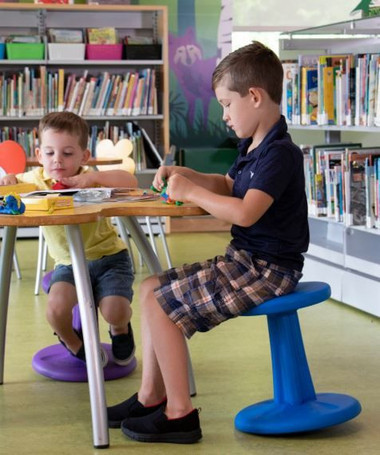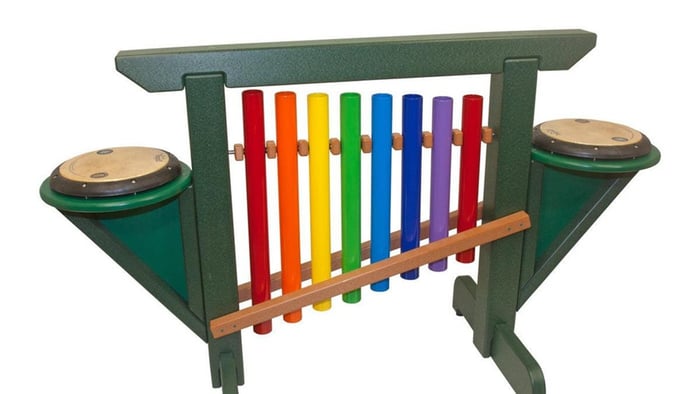
How to Build a Fun Library Sensory Room for Kids
Table of Contents
- Transform your library into an inclusive haven with sensory spaces for neurodivergent children. Learn how to create both high-sensory and low-sensory environments using visual, tactile, and movement elements—on any budget from DIY solutions to fully-equipped rooms.
- Key Takeaways:
- Why do Libraries Need a Sensory Room
- Understanding Sensory Processing Challenges in Library Settings
- Two Essential Types of Sensory Spaces
- Must-Have Elements for an Effective Library Sensory Room
- Building Your Library Sensory Room: Practical Steps
- Measuring Success and Making Improvements
- Create a More Inclusive Library Experience Today
- FAQs
Transform your library into an inclusive haven with sensory spaces for neurodivergent children. Learn how to create both high-sensory and low-sensory environments using visual, tactile, and movement elements—on any budget from DIY solutions to fully-equipped rooms.
Key Takeaways:
- Library sensory rooms create inclusive spaces for children with autism, sensory processing disorders, and other neurodivergent conditions.
- There are two primary types of sensory spaces to consider: high-sensory (for sensory-seeking children) and low-sensory (for sensory-avoidant children).
- Library sensory rooms can be created on various budgets, from no-cost options using repurposed items to fully-equipped dedicated spaces.
- Little People's Cove offers resources and expertise on creating child-friendly sensory environments that promote learning and development.
- Effective sensory rooms include elements that address multiple senses: visual, tactile, auditory, and proprioceptive needs.
Why do Libraries Need a Sensory Room
For many children, particularly those with sensory processing challenges, autism, or ADHD, a traditional library environment can be overwhelming and inaccessible. What should be a place of discovery and joy can quickly become a source of stress and anxiety. The fluorescent lighting, expectation of quiet voices, and vast array of visual stimuli can trigger sensory overload in sensitive children.
Sensory rooms in libraries offer a solution to this challenge. By creating dedicated spaces specifically designed to support sensory needs, libraries can become truly inclusive community hubs where all children feel welcome. These specialized environments provide opportunities for children to self-regulate their sensory experiences, decompress when feeling overwhelmed, and engage with library resources in ways that work for their unique neurological makeup.
Creating sensory-friendly spaces isn't just beneficial for neurodivergent children – it transforms the library experience for entire families. As Little People's Cove has observed through their work with children's environments, when spaces are designed with sensory needs in mind, children who might otherwise avoid libraries can develop comfort, confidence, and ultimately a love of reading and learning.
Beyond serving neurodivergent users, sensory rooms benefit the broader community. They provide alternative spaces for any child who might need a break from traditional library settings, offer families with diverse needs a place to enjoy library services together, and demonstrate a library's commitment to true accessibility and inclusion for all.
Multi Sensory Learning Cube

$2,489.36
The HABA Multi Sensory Learning Cube is packed with delightful activities to explore. The top features a drive through the forested countryside, viewable through colored prisms....… read more
Understanding Sensory Processing Challenges in Library Settings
1. Common triggers in traditional libraries
Traditional libraries, despite being designed as quiet sanctuaries of learning, contain numerous potential sensory triggers that can overwhelm children with sensory processing differences. Fluorescent lighting casts a harsh glow and may emit an imperceptible (to most) buzzing sound that can be distressing for sensitive individuals. The expectation to maintain quiet can create anxiety in children who struggle with impulse control or need movement to regulate. Even the typical library layout with tall shelves creating maze-like pathways can be disorienting for some children.
Other common library triggers include:
- Unexpected sounds like book carts, closing doors, or whispered conversations
- Strong smells from cleaning products, books, or other patrons
- Visual overstimulation from colorful book displays and signage
- Social pressure to conform to library behavior expectations
- Transitions between different library areas or activities
2. How sensory overload affects learning and enjoyment
When a child experiences sensory overload, their nervous system enters a state of fight, flight, or freeze. In this state, the brain's ability to process new information, focus on tasks, or engage in learning activities is severely compromised. What might look like a behavioral issue—a meltdown, withdrawal, or inability to follow directions—is actually a physiological response to overwhelming sensory input.
Sensory overload can transform what should be an enjoyable library visit into a stressful experience for both children and caregivers. Instead of discovering new books or participating in programs, the child may become fixated on escaping the overwhelming environment. This not only disrupts their current library visit but can create negative associations that prevent future engagement with library resources.
3. Benefits of dedicated sensory spaces for all children
Dedicated sensory spaces benefit not only children with diagnosed sensory processing challenges but all library users. These spaces provide:
- Opportunities for sensory regulation before overwhelm occurs
- Safe spaces to decompress when feeling stressed or overstimulated
- Alternatives to traditional seating that accommodate different body needs
- Inclusive environments that welcome diverse neurological experiences
- Resources for families to learn about sensory regulation strategies
By offering dedicated sensory spaces, libraries send a powerful message of inclusion and demonstrate their commitment to serving all community members. These spaces acknowledge that different brains function differently and that accommodating these differences enriches the library experience for everyone.
Sensory Truck Activity Center

$1,412.43
Delight your youngest while they experience new shapes, textures, materials and sounds on our Sensory Truck. Stimulates sight, touch and hearing senses. Perfect for early...… read more
Two Essential Types of Sensory Spaces
1. High-Sensory (Sensory-Seeking) Environments
Some children, particularly those with sensory-seeking tendencies, benefit from spaces that provide additional sensory input. These high-sensory environments are designed to engage multiple senses in a controlled, positive way. They might include:
- Vibrant colors and varied textures to explore
- Interactive elements like bubble tubes or fiber optic lights
- Movement opportunities such as rocking chairs or wobble stools
- Fidget tools and manipulatives for hands-on engagement
- Games and activities that encourage sensory exploration
High-sensory spaces are ideal for children who need additional sensory input to regulate their nervous systems. By providing appropriate sensory experiences in a controlled environment, these spaces help children satisfy their sensory needs without disrupting other library users.
2. Low-Sensory (Sensory-Avoidant) Environments
In contrast, low-sensory environments cater to children who are easily overwhelmed by sensory input. These calming spaces minimize sensory stimulation and provide tools for self-regulation. Key elements include:
- Reduced visual stimulation with neutral colors and minimal decorations
- Sound-dampening materials to minimize noise
- Adjustable or dimmable lighting options
- Comfortable seating like bean bags or weighted cushions
- Quiet activities such as reading or puzzles
- Personal space boundaries that are clearly defined
Low-sensory spaces offer a sanctuary for children who need to retreat from overwhelming environments. They provide a calm atmosphere where children can regain their equilibrium before reengaging with more stimulating library activities.
Active Learning Wobble Stool, 14"H

$77.28
Active Learning Wobble Stool, 14"H with it's rounded bottom creates a rocking motion which encourages active sitting. Increases learning retention, improves balance and memory. Perfect for...… read more
Must-Have Elements for an Effective Library Sensory Room
1. Visual stimulation components
The visual environment plays a crucial role in any sensory room. For a library setting, consider incorporating:
- Bubble tubes or columns that provide mesmerizing visual tracking opportunities
- Fiber optic light strands that can be safely handled and manipulated
- Projectors that display gentle, moving patterns on walls or ceilings
- Light panels for examining transparent colored objects
- Visually simple areas with minimal distractions for those who need visual breaks
When selecting visual elements, aim for variety that allows children to adjust their visual input based on their needs. Include options that can be turned on/off or adjusted in intensity to accommodate different preferences.
2. Tactile exploration materials
Tactile input is essential for many children's sensory regulation. Effective tactile elements include:
- Texture walls or boards with various surfaces to touch and examine
- Fidget toys with different textures, weights, and manipulation options
- Sensory bins filled with materials like kinetic sand, beans, or water beads
- Weighted items such as blankets, lap pads, or stuffed animals
- Various fabric swatches from smooth satin to nubbly corduroy
Ensure all tactile materials are durable, washable, and safe for children of various ages. Rotate items periodically to maintain interest and engagement.
3. Comfortable seating options
Flexible, comfortable seating is fundamental to a successful sensory room. Consider:
- Bean bag chairs that provide gentle pressure and conform to the body
- Floor cushions in various sizes and firmness levels
- Rocking chairs that provide vestibular input
- Wobble stools or therapy balls for active sitting
- Enclosed spaces like tents or canopies for those seeking security
Arrange seating to create both individual spaces and small group areas, allowing children to choose their level of social engagement.
4. Movement and proprioceptive tools
Many children need movement to regulate their sensory systems. Safe movement options include:
- Balance boards or stepping stones
- Rocking or swinging furniture (where space permits)
- Resistance bands attached to chair legs
- Wall-mounted activity panels that encourage reaching and stretching
- Compression options like lycra tunnels or body socks
Even in small spaces, adding elements that allow for movement can significantly improve a sensory room's effectiveness.
5. Calming features for de-escalation
Every library sensory room should include elements specifically designed to help with de-escalation and calming:
- Noise-canceling headphones or earmuffs
- Soft, dimmable lighting options
- White noise machines or gentle nature sounds
- Visual timers to help with transitions
- Breathing guides or simple mindfulness activities
These calming tools can help children who are approaching sensory overload to regain their equilibrium.
Building Your Library Sensory Room: Practical Steps
1. Location considerations and space requirements
Selecting the right location is crucial for a successful sensory room. Consider these factors:
- Noise level: Is the space naturally quiet, or can it be soundproofed?
- Accessibility: Is it easily accessible for all users, including those with mobility devices?
- Visibility: Can staff monitor the space while respecting users' privacy?
- Size: Is there enough room for the planned activities and equipment?
- Existing features: Does it have windows (natural light) or dimmable lighting?
Even small spaces can become effective sensory rooms with thoughtful planning. A converted study room, unused office, or partitioned corner of the children's area can work well. The Montana State University Library transformed an underutilized corner into a vibrant sensory-seeking space, showing that existing spaces can be repurposed effectively.
2. Budget options from zero-cost to fully equipped
Sensory rooms can be created on virtually any budget:
Zero-Cost Options:
- Repurpose existing furniture and materials
- Ask for donations of gently used sensory items from the community
- Create DIY sensory bottles, weighted items, and visual displays
- Designate a quiet corner with existing comfortable seating
Low-Budget Options ($100-500):
- Purchase essential items like a bean bag chair, noise-canceling headphones, and basic fidgets
- Add inexpensive lighting like LED strip lights or a small lamp with color-changing bulbs
- Invest in a few high-quality sensory tools that serve multiple purposes
Moderate Budget ($500-2,000):
- Add specialty furniture like wobble stools or sensory seating
- Purchase a bubble tube or fiber optic light bundle
- Include a wider variety of sensory tools and materials
- Install sound-dampening panels or curtains
Full Investment ($2,000+):
- Install permanent features like built-in sensory walls or specialized lighting
- Purchase commercial-grade sensory equipment
- Create multiple zones for different sensory needs within the space
Effectiveness doesn't necessarily relate to cost. A thoughtfully designed low-budget space can be more beneficial than an expensive room with poorly chosen elements.
3. Implementation timeline and phased approach
Implementing a sensory room works best when approached in phases:
Phase 1: Planning and Preparation (1-2 months)
- Research sensory rooms and identify needs specific to your library users
- Consult with occupational therapists or special education professionals if possible
- Survey families in your community about desired features
- Develop a budget proposal and secure funding
- Select and prepare the location
Phase 2: Initial Implementation (2-4 weeks)
- Set up the basic environment (furniture, lighting, and essential items)
- Train staff on the purpose and use of the space
- Develop policies for room usage and scheduling
- Create user guides and orientation materials
Phase 3: Expansion and Refinement (Ongoing)
- Gather feedback from users and make adjustments
- Add new elements based on observed needs and user requests
- Rotate materials to maintain engagement
- Continue staff training on supporting users with sensory needs
This phased approach allows for learning and adaptation throughout the process, ensuring the sensory room meets the specific needs of your library community.
Ladybug Seating Set

$1,309.41
This Ladybug is good luck! Sit together with friends at this creative and colorful table set. A beautiful form in a charming version of a...… read more
Measuring Success and Making Improvements
To ensure your sensory room continues to meet users' needs, establish ongoing assessment practices:
- Create a simple feedback form for users and families
- Track usage patterns to identify peak times and user demographics
- Observe how different elements are being used and which may need adjustment
- Hold periodic focus groups with families to gather more detailed feedback
- Document successes and challenges to inform future decisions
Be prepared to make changes based on feedback. What works in one library may not work in another, and what works for one user may not work for all. Flexibility and responsiveness are key to a successful sensory room.
Real success stories from libraries with sensory rooms consistently show that these spaces become valued resources for the community. Users frequently report feeling included, and libraries see increased visits from families who previously found the library environment challenging.
Create a More Inclusive Library Experience Today
Building a sensory room in your library is more than just creating a special space—it's making a statement about inclusion and accessibility. By acknowledging and accommodating diverse sensory needs, you're transforming your library into a place where all children can discover the joy of reading and learning.
Whether you start with a modest quiet corner or develop a fully-equipped sensory room, the impact on your community will be significant. Children who may have previously avoided the library due to sensory challenges can now find a welcoming environment that supports their needs.
Creating a sensory room is an ongoing process. As you learn more about the specific needs of your users and as sensory-inclusive practices develop, your space will grow and change. Take pride in this process of continuous improvement, and celebrate the positive differences you're making in children's lives.
Little People's Cove specializes in creating environments where all children, regardless of sensory needs, can thrive and learn.
FAQs
Why do libraries need sensory rooms for children?
Libraries can unintentionally overwhelm children with sensory sensitivities—bright fluorescent lighting, maze-like shelving, and ambient noise can trigger stress or anxiety. Sensory rooms offer controlled, calming environments where children, especially those with autism, ADHD, or sensory processing differences, can self-regulate, decompress, and re-engage in learning. These inclusive spaces transform libraries into welcoming environments for all families.
What are the differences between high-sensory and low-sensory spaces?
There are two main sensory room types:
High-sensory spaces cater to children who actively seek stimulation, featuring bright colors, tactile textures, interactive lights, and movement tools.
Low-sensory spaces serve children who are easily overwhelmed, offering neutral tones, dim lighting, noise reduction, and calming seating for sensory retreat and regulation.
Together, these complementary spaces serve a wide range of sensory needs.
Can libraries create sensory rooms on a budget?
Absolutely! Effective sensory spaces can be built with minimal investment. Libraries can repurpose existing furniture, create DIY sensory tools (like sensory bottles or textured displays), and set up calming corners with beanbags and soft lighting. Later, they can expand with moderate investments—adding items like bubble tubes or fiber-optic lights. Thoughtful, budget-conscious design often yields more meaningful results than expensive but poorly tailored setups.



